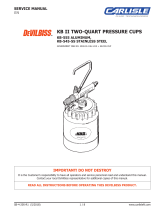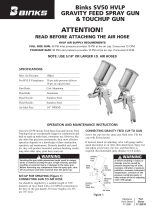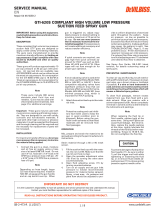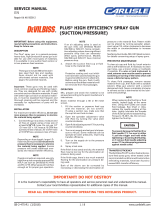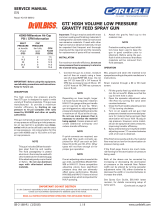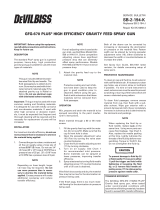Page is loading ...

DEVILBISS
SERVICE BULLETIN
SB-4-395-C
Replaces SB-4-395-8
Repair
Kit
KK-5008
TSC-595 STAINLESS STEEL DRIP
FREE
SUCTION CUP
Important: Before using
this
equip-
ment, read all
safety
precautions
and
instructions.
Retain
for
future
use.
Figure 1
Product is
covered
by U.S.A.
Patent
Nos.
287.994, 4,760,753
DESCRIPTION
Model: TSC-595
Thread
Size:
3/4"
NPS
Weight:
20
ounces
The
TSC-595 stainless steel, 1
quart
ca~
pacity cup has a unique,
two
position
valve
which
permits selection
of
either
a
drip
free spraying
mode
or
a
conventional
open vent mode.
The
stainless steel cup is
designed
for
use
with
corrosive
type
materials, such
as
waterbornes. This cup is also suitable
for
use with finishes
containing
halogenated
hydrocarbon solvents.
In
the drip free
position,
air is directed
through
the vent
in
the
lid
to
a channel
beneath
the
gasket before entering the cup
atthe
valve. This
allows
the
cup to be
tilted
when full
without
dripping
paint
through
the
vent. The cup can also be inverted
momentarily
while
spraying
without
leaking.
The
open position isolates
the
channel
and opens a
direct
vent
into
the
cup.
The
position
of
the
valve is indicated
by
alignment
of
the
hole in
the
valve
slot
with
the
marks cast on
the
lid. These
positions
are identified
as
"0"
for
vent
open and
"D/P'
for
Drip Free.
INSTALLATION
1.
Position yoke at
right
angle
to
gun
body
with
vent hole in
lid
toward
rear and lever
of
cam {3)
toward
front
of
gun.
2. Fasten cup
lid
assembly
to
gun
by
attaching
nut
(2), see Figure 4,
to
fluid
inlet nipple
on gun.
Tighten
nut
with
wrench.
3. Strain
material
to
be sprayed
through
a 60-90 mesh screen before
pouring
into
cup.
4.
Engage
pins
on
cup
into
yoke and tighten yoke
by
moving
lever
of
cam clockwise.
OPERATION
Open
Vent
Mode
"Q"w
To
operate in the open vent mode, rotate the valve
with
a
screwdriver
or
coin so
that
the
hole in the valve slot is aligned
with
the
"0~
on the lid.
See
Figure 2.
If
the valve slot
hole
should
plug
while
operating in the
"0"
vent
mode,
use a pointed
tool such
as
a nail
or
drill
bit
to
probe
through
the valve slot hole
to
clear away the
obstruction.
Channel
Vent Hole
UdTop
(Do
Not
Probe)
Figure 2
~
Open
Vent
Mode
Valva slot
hole can
be
probed to clean.
Ud
Underside
partially removed
Valve in Open Position
Drip Free
Mode
"D/F"
- To operate
in
the
drip
free mode, rotate the valve with a
screwdriver
or
coin so
that
the
hole in the valve slot is
aligned
with
the "D/F" on the
lid. See Figure
3.
Do
not
probe
through
the
channel
vent
hole
at
any
time.
Do
not
probe
through
the
valve
slot
hole
while
the
valve is in
the
"D/F"
position.
These holes are
sealed
by
a
gasket
and
gasket
damage
could result. See Figures 2 and 3.
Lid Top
'
Figure 3 -
Drip
Free
Model
hole sealed ·
{Do Not Probe)
Valve
in
Drip
Free
Position
Lid Underside
partially removed.
Valve
Movement
w
Do
not
forcibly
rotate the valve.
If
it
will
not
move
freely, soak in
solvent
or
remove
the
lid
assembly
from
thee
up and press
down
on
the
top
of
the
valve
until
it
breaks free.
The
valve has free travel vertically
of
about
1/8". This can be used
to
push
out
the
gasket.

Page 2 SB-4-395-C
SAFETY PRECAUTIONS
This manual contains important information that ALL users should
know
and understand
BEFORE
using the
equipment. This information relates
to
USER
SAFETY and
PREVENTING
EQUIPMENT PROBLEMS. To help you
recognize this
information,
we
use
the
following
terms to
draw
your
attention
to
certain
equipment
labels and
portions
of
this manual.
Pay
special attention
to
any label or information that
is
highlighted by one
of
these terms:
Note
WARNING I
Important
information
to
alert you
to
a situation that might cause
injury or loss
of
life.
Important
information
that
tells
how
to
prevent damage
to
equipment
Information that you should
pay special attention to.
WARNING I
The
following hazards
may
occur during
the
normal use of this equipment. Please read
the
following chart.
HAZARD
Fire
Explosion Hazard
-
Incompatible
Materials
Inhaling Toxic Substances
CAUSE
Solvents
and
coatings can be highly
flammable
or
combustible,
especially
when sprayed.
During
cleaning and
flushing,
solvents
can be
forcefully
expelled
from
fluid
and
air
passages.
Some
solvents can
cause eye
injury
or
irritation.
Chlorinated solvents, such
as
1,
1,1-
Trichloroethane and Methylene
Chloride
(sometimes
called
methyl
chloride) can
chemically
react
with
aluminum
used in
many
spray system
components
to
produce
an
explosion
hazard.
Certain materials
may
be
harmful
if
inhaled,
or
if
there
is
contact
with
the skin.
SAFEGUARDS
Do
not
spray near
open
flames,
pilot
lights
in
stoves
or
heaters,
or
other
heat sources.
Adequate
ventilation
must
always be provided.
Industrial
applications
must
comply
with
OSHA
requirements.
Wear eye
protection.
1.
Read
the
label
or
data sheet for
the
material
you
intend
to
spray.
2.
Do
not
use any
type
of
coating material
containing
these solvents
with
components
containing
aluminum.
3.
Do
not
use these solvents
for
equipment
cleaning
or
flushing.
4.
If
in
doubt
as
to
whether
a material is
compatible,
contact
your
material supplier.
Follow
the
requirements
of
the
Material Safety
Data Sheet
supplied
by
your
coating material
manufacturer.
Adequate exhaust
must
be
provided
to
keep
the
air free
of
accumulations
of
toxic
materials.
Use a mask
or
respirator
whenever
there is a
chance
of
inhaling
sprayed materials. The mask
must
be
compatible
with
the
material being
sprayed and
its
concentration.
Equipment
must
be as prescribed
by
an
industrial
hygienst or
safety expert, and be
NlOSH approved.

MAINTENANCE
Lid
Repair/Replacement:
1. To
replace a damaged part, use a 5/16
inch Allen
wrench
to
loosen and re-
move
adapter
(1).
The
nut
(2), yoke,
cam
(3}
or
lid
and
tube
assembly are
now
loose
for
replacement.
2.
Replace damaged parts. The cam
le-
ver
should be located on
opposite
side
of
lid
from
valve
(4}.
3.
Apply
sealant (loctite #262)
to
the
first
two
full
threads
of
adapter (1).
Insert threaded end
of
adapter
into
open end
of
nut
(2).
4.
Install adapter
{1)
and
nut
(2)
in
top
of
lid and
tube
assembly. Use a 5/16"
Allen
wrench
to
tighten
firmly
(10-12
foot
pounds).
Valve and
Lid
Gasket Replacement:
1. To
remove
a damaged valve
(4)
or
lid
gasket (5), press on
top
of
valve
until
it
breaks free. The valve pushes
the
lid gasket
from
the
seat
The
lid
gas-
ket
may
now
be
removed
from
the
lid. Continue pressing hard on
the
valve
to
remove
it
from
the lid.
2. Install replacement valve
(4)
through
bottom
of
lid so
that
the valve tab is
toward
center
of
lid. Snap in place.
If
necessary, use a plastic
mallet
or
screwdriver
handle to
tap
the valve
in place.
Press
the
lid
gasket
firmly
in
the
lid using the
end
of
a crescent
wrench.
Insert
the
side
with
the
black marks first.
CLEANING
General: For routine cleaning,
it
is
not
necessary
to
remove
the
lid gasket. It is
not
necessary
or
desirable
to
remove
the
valve
for
anycleaning procedure. The valve
can be depressed
from
the
outside
to
assist
in
removal
of
the gasket
for
gasket
replacement
orwhen
cleaning dried
paint
from
the
channeL The valve
should
not
be
forced
past
the
shoulder
which
retains
it
in
the
lid
except for replacement.
Note
The cam and
mating
surfaces
on
the
lid and yoke
normally
don't
require removal
for
cleaning.
Spraying some materia
Is
contain-
ing
Teflon~·'
or
similar
materials
can necessitate
more
frequent
cleaning and possible disassem-
bly
of
the
cam. The overspray
containing
Teflon&"
can
build
up
on
the
cam and
mating
surfaces
causing a
condition
where the
cam
may
loosen
during
use.
Air
Pressure:
Always
clean
with
reduced
air
pressure.
An
air
pressure
no
greater
than
15
to
20 psi
will
allow
quick and
thorough
cleaning
of
the
cup and gun
and at
the
same
time
will:
1.
Minimize
the
amount
of
solvent
atomized
into
the
air.
2.
Prevent
possibility
of
damage
to
cup
from
excessive back pressure.
3.
Reduce the force
with
which
solvent
is expelled
from
the
vent.
Cleaning Procedures:
1.
Empty
paint
from
cup and add small
amount
of
clean
solvent.
The
amount
required
will
vary
with
different
coatings
and solvents.
2.
Shake cup
to
wash
down
inside sur-
faces. Then spray
solvent
at
low
air
pressure (15-20 psi)
to
flush
out
fluid
passages.
3.
Pour
out
solvent
and
add
same
amount
of
clean solvent.
4a. Again, shake cup. Loosen
air
cap.
Hold a
folded
cloth
over
front
of
gun
and
invert
cup
over
solvent
recep-
tacle.
Trigger
with
short
bursts
to
back flush
vent
channel.
With
valve
in
0/F
position,
solvent
will
be
expelled
with
force
from
the
channel
vent
hole
in
lid.
Alternative
to
Step
4a.
4b.
Shut
off
air
to
gun.
With
valve in D/F
position,
invert
cup
over
solvent
re-
ceptacle.
Trigger
gun. AHow
solvent
to
drip
out
channel
vent
hole in lid
for
several seconds,
or
until
clean
solvent
is seen.
5.
Clean cam and
mating
surface on lid
with
a
solvent
soaked Scotch™ pad
and
blow
dry.
If
cam loosening per-
sists, removal
of
the yoke and cam
will
be required
for
more
thorough
cleaning
of
these parts. Again, use a
solvent
soaked Scotch TM pad
for
this
purpose. Reassemble lid.
• Do
not
probe
through
the
chan-
nel
vent
hole
at
any
time.
Do
not
probe
through
the
valve
slot
hole
while
the
valve is
in
the
D/F
posi-
tion.
These
holes
are
sealed
by
gasket
15)
and
gasket
damage
could occur.
•
Cup
assembly
may
also
be
cleaned
with
a
gun
washer.
Folk
low
directions
of
gun
washer
manufacturer.
SB-4-395-C
Page
3
IMMERSION
Since all materials in the cup are
highly
solvent
resistant
the cup assembly
may
be
immersed
for
cleaning. Immersion
should
not
exceed 24 hours. The
use
of
paint
strippers should
be
avoided be-
cause strippers
will
affect the alum-
inum
as
welt
as
other
non-metallic
components.
If the lid gasket has be-
come
swollen
from
prolonged expo·
sure
to
solvents,
'1t
will
return to its
original
size
without
loss
of
properties
when
allowed
to
dry.

Page 4
SB-4-395-C
Parts List
Ref.
Replacement
No.
Part
No. Description
1*
---
Adapter,
1/2"
NPS
(MI
2*
---
Nut,
3/8"
NPS
IFI
3*
---
Cam
4*
TGC-407-1-K3
Drip
Free
Valve
and
Gasket
(Kit
of
3)
5*
TGC-9-K5
**Tri Seal•
lid
Gasket
(Kit of
5)
6
TSC-407
lid
Assembly
7
TSC-400
Cup
Assembly
(Stainless Steel
Quart)
Ind.
Parts
Req.
1
1
1
1
1
1
1
*KK-5008 Repair Kit includes Ref. Nos.
1-5.
Repair
kit
contains
enough
parts
to
repair
one
complete assembly.
Suffix
-K3
designates a kit
of
multiple
parts.
Example: TGC-407-1-K3 is a kit
of
3 drip free valves.
** Registered Trademark
of
Tri~SeallnternationaL
WARRANTY
This
product
is
covered
by
DeVilbiss' 1 Year
Limited
Warranty. See SB-1-000
which
is available upon request.
WORLDWIDE SALES AND SERVICE -
www.devilbiss.com
Figure
4
--
Apply sealant to
first two threads
(Loctite
#262).
2
INDUSTRIAL SPRAY
EQUIPMENT-
DeVilbiss has authorized
distributors
throughout
the
world.
FOR TECHJI'JICAL
ASSISTANCE
OR THE DISTRIBUTOR
NEAREST
YOU,
CALL
TOLL
FREE
1-888-992-4657 (U.S.A.
AND
CANADA ONLY).
DEVILBISS
3/03 ©Copyright 2003,
Printed in U.S.A.
/



